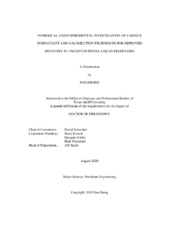| dc.description.abstract | In order to extend the economic life of existing horizontal wells and improve oil production for newly drilled wells in unconventional liquid reservoirs (ULR), testing of enhanced oil recovery (EOR) techniques is essential. The interaction of the fluids in the fractures system with the oil stored in the matrix is the key to understanding and implementing all EOR techniques in ULR. This study focuses on investigating the performance of different EOR agents (surfactant, CO₂, rich gas, and foam) through laboratory tests as well as upscaling the experimental data to field-scale through numerical simulation.
A correlated set of Huff-n-Puff and spontaneous imbibition experiments were performed at reservoir temperature using different surfactants, gases, and foam on side-wall core samples from the Wolfcamp and the Eagle Ford formations. The experimental setup was mounted into a Computed Tomography (CT) Unit (CTU) to capture time-lapse CT images which were used to monitor the fluid movement inside the core plugs, track the foam quality in glass beads around the cores, and construct core-scale simulation models. A comprehensive upscale workflow was proposed by combining the results of laboratory data, scaling group analysis, core-scale history match, and field-scale prediction. The scaling parameters are achieved from history-matching laboratory data, which are implemented in the field-scale reservoir model to estimate the production enhancement through surfactant and gas injection EOR techniques.
Different gases (CH₄, a mixture of 85% CH₄ - 15% C₂H₆, enriched gas (50% CH₄ - 50% C₂H₆), and CO₂) were tested to explore the effects of gas composition on the recovery factor in ULR. Enriched gas (50% CH₄ - 50% C₂H₆) showed the most promising potential of improving oil recovery in the Wolfcamp formation. Increasing pressure does not always lead to a higher recovery, such as high pressure (beyond 5,000 psi) CO₂ injection. The primary mechanism of gas injection is multi-contact miscibility, and diffusion has a minor effect on enhancing oil recovery in ULR. Surfactants enhance oil recovery by wettability alteration and interfacial tension (IFT) reduction. Implementing surfactant into completion fluids or re-frac fluids results in additional oil recovered from ULR. From the results obtained, a combination of EOR techniques (foam or sequencing surfactant and gas injection) opens the possibility to achieve optimum oil recovery in ULR. | en |


